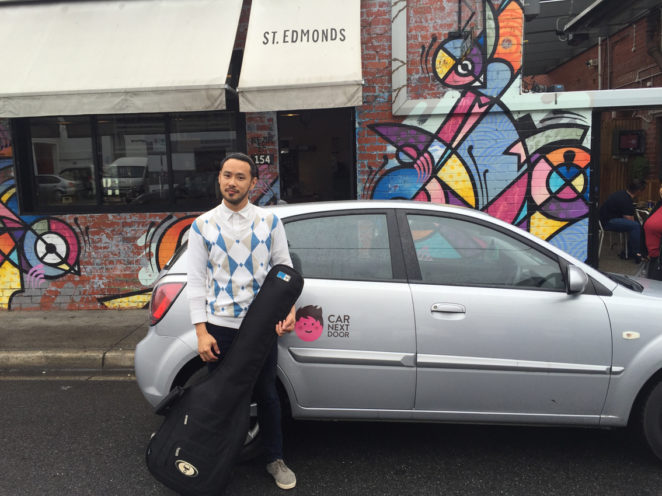
You’ve put in many years of hard work and you’re starting to get some regular gigs (or maybe even a tour!) coming in. Now for your next challenge: how do you transport all your band members and their gear to all the gigs filling up your calendar?
The obvious answer is to get a van, but once you start looking into it you’ll realise that it’s not as simple as it sounds. What size van do you need? Is it better to hire or buy? What’s a reasonable price for a van and how can you avoid spending all your gig money on transport?
Choosing the best van for a touring band
When you’ve got a lot of gear and people to transport, you need to consider which van you hire or buy carefully. There’s nothing worse than finding yourself playing an unwinnable game of giant Tetris with a drum kit, guitars and amps when you’ve got a gig to get to!
Make sure you think about these key things before hiring or buying a van for your band:
• How many seats do you need? Many vans only have two or three seats, so consider if other band members can get themselves to the gig or if you need a van with enough seats for everyone.
• How much gear do you need to transport? Having a rough idea of the dimensions of all your gear will help you work out how much cargo space you’ll need in the van before you hire or buy one.
• How can you be as fuel efficient as possible? It’s easy to forget to count the cost of fuel, but with a van loaded up with people and gear this can quickly add up. As a general rule, the smaller the van the more fuel efficient it will be. Consider how you can cut down on what you’re hauling around, for example by leaving a couple of those extra guitars at home or going for combo amps instead of full or half stacks.
Hiring a van for your band
There are two main options for hiring a van: a traditional car hire agency or a car-sharing service. Both options allow you to rent a van, but the way they work is a little different.
A traditional car hire agency requires a bit of forward planning: you’ll need to book the van in advance to make sure your local depot has a van available on the day you need it. You’ll also need to get to the depot during the opening hours and fill in some paperwork when you pick up and drop off the van. If you supplement your gig income with a day job, this can be a bit tricky.
Car-sharing services like Car Next Door are a much more flexible van hire option. You can book instantly using an app or website, so even the most last-minute gig is covered. These services also let you book by the hour or the day, so if you only need a van for a few hours at night you won’t need to pay for a whole day. The vans are typically parked in streets and driveways in your neighbourhood, so you don’t need to head all the way to the depot for pick up and drop off.
Buying a cheap van for your band
You’ve been saving up and you’re ready to make the plunge and buy a van of your own. Even a second hand van will set you back a pretty penny, so it’s tempting to go for the cheapest one you can find. The bad news is that van maintenance bills can easily set you back thousands of dollars, so the cheapest second hand van might not be the most economical option in the long run. Make sure the van you buy is well-maintained and reliable.
When you’re a musician and not a mechanic, it’s not easy to know a reliable workhorse from a dud deal. The good news is that there are a few simple checks that don’t require any mechanical know-how and will give you a good idea of how well the van’s been looked after.
• Check for rust – Take a look at the van’s bodywork for any signs of rust. If you find any push down on it gently – if you hear cracking sounds, there may be corrosion on the van’s body.
• Push down on each corner of the van – If the van bounces once then stabilises, that’s a sign that its suspension is in good condition.
• Check the lights – If a van’s lights are flickering or dim it could be a sign that its electronics aren’t in the best shape.
• Test the brakes – Take the van for a test drive and pay attention to how the brakes perform. Be cautious of any squealing or grinding sounds, or brakes that don’t respond well.
• Check the tyres – Put a 20c coin into one of the grooves (tread) on the tyres. If the tread doesn’t reach the platypus’ bill, the tyre tread is too low. You can always buy new tyres, but take this into account when considering the purchase price of the van.
A van’s age isn’t always a sign of its quality. An older van that’s been well-maintained can still have plenty of life left, so don’t be put off from buying a van just because it’s an older model. There are plenty of good deals to be had on older, reliable vans!
Once you’ve found a van that looks good, it’s worth getting it checked over by a mechanic to make sure you’re not in for any ugly surprises. When you’re looking at spending $15,000+ on a van, a few hundred dollars for a mechanic check could end up saving you thousands in the long run.
Car Next Door: a cost-effective and convenient alternative
Buying a van might seem like the easiest option – you’ll have a van ready to go whenever you need it – plus it’s a sign that you’ve really made it. But vans aren’t cheap vehicles to own and run, and unless you’re touring pretty much constantly they can be a really wasted resource.
That’s where Car Next Door comes in. Car Next Door is a car-sharing service that lets you borrow cars, vans and utes from real people in your neighbourhood by the hour or day. It’s a really cost-effective way to use a van, with rates starting at around $9 an hour and $40 a day, plus distance charges.
Once you’ve joined Car Next Door for free, you can book vans near you instantly for the times you need them and pick them up in just a few minutes using the app. Comprehensive insurance, roadside assistance and 24/7 member support are included with every trip, so you’re always covered if the unexpected happens.


